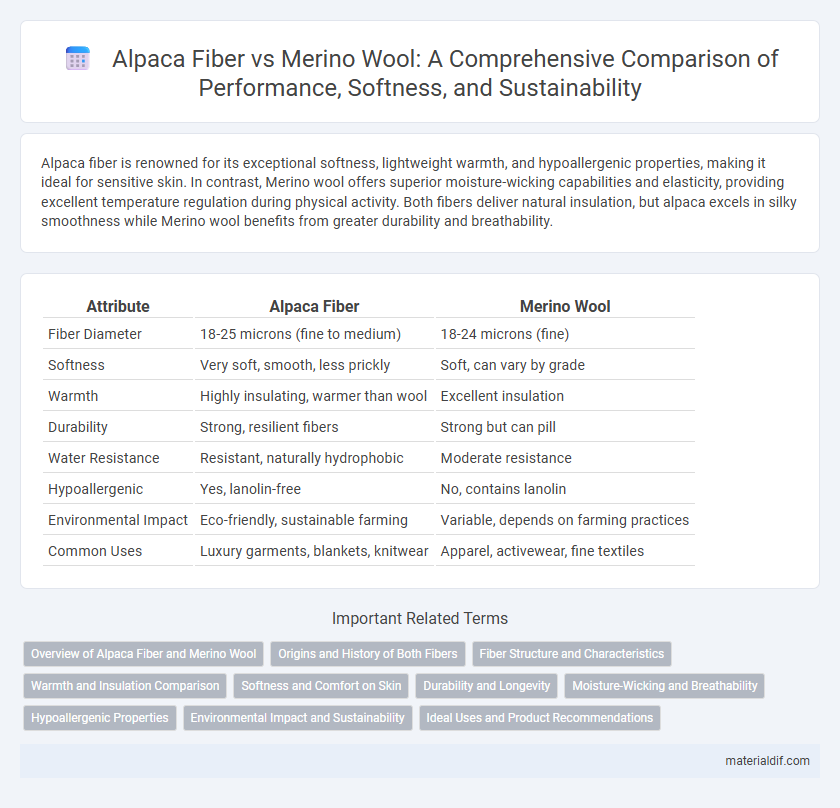Alpaca fiber is renowned for its exceptional softness, lightweight warmth, and hypoallergenic properties, making it ideal for sensitive skin. In contrast, Merino wool offers superior moisture-wicking capabilities and elasticity, providing excellent temperature regulation during physical activity. Both fibers deliver natural insulation, but alpaca excels in silky smoothness while Merino wool benefits from greater durability and breathability.
Table of Comparison
| Attribute | Alpaca Fiber | Merino Wool |
|---|---|---|
| Fiber Diameter | 18-25 microns (fine to medium) | 18-24 microns (fine) |
| Softness | Very soft, smooth, less prickly | Soft, can vary by grade |
| Warmth | Highly insulating, warmer than wool | Excellent insulation |
| Durability | Strong, resilient fibers | Strong but can pill |
| Water Resistance | Resistant, naturally hydrophobic | Moderate resistance |
| Hypoallergenic | Yes, lanolin-free | No, contains lanolin |
| Environmental Impact | Eco-friendly, sustainable farming | Variable, depends on farming practices |
| Common Uses | Luxury garments, blankets, knitwear | Apparel, activewear, fine textiles |
Overview of Alpaca Fiber and Merino Wool
Alpaca fiber is a natural animal fiber known for its exceptional softness, warmth, and lightweight qualities, making it highly sought after for luxury textiles and outdoor apparel. Merino wool, derived from Merino sheep, is prized for its fine, breathable, and moisture-wicking properties, commonly used in high-performance and thermal clothing. Both fibers offer excellent insulation and comfort, with alpaca fiber providing greater hypoallergenic benefits due to the absence of lanolin.
Origins and History of Both Fibers
Alpaca fiber originates from the Andean regions of South America, where it has been prized for thousands of years due to its softness and thermal insulation, with its use dating back to pre-Incan civilizations. Merino wool comes from Merino sheep, primarily raised in Spain and later in Australia and New Zealand, with a history extending back to ancient times and gaining global prominence in textile production during the 18th and 19th centuries. Both fibers have cultural significance and distinct historical paths that highlight their unique qualities and global impact on the fiber industry.
Fiber Structure and Characteristics
Alpaca fiber features a hollow core that provides superior insulation and moisture-wicking properties compared to the solid, fine scales of Merino wool fibers that offer excellent elasticity and softness. The diameter of alpaca fibers typically ranges from 18 to 25 microns, making them coarser but more durable than the finer 15 to 20 microns Merino wool fibers known for their smooth texture. Alpaca fiber's lack of lanolin results in a hypoallergenic, lightweight fleece, while Merino wool maintains natural water repellency and crease resistance due to its crimped fiber structure.
Warmth and Insulation Comparison
Alpaca fiber offers superior warmth compared to Merino wool due to its hollow core structure, which traps heat more effectively and provides excellent insulation in cold conditions. Merino wool excels in moisture-wicking and breathability but generally retains less heat under damp conditions than Alpaca fiber. Both fibers provide natural thermal regulation, but Alpaca's lightweight loft and low thermal conductivity make it a preferred choice for maximum warmth and insulation performance.
Softness and Comfort on Skin
Alpaca fiber is renowned for its exceptional softness, often feeling smoother and less scratchy than Merino wool due to its finer, hollow fibers that trap heat while remaining lightweight. Merino wool offers excellent moisture-wicking properties and breathability, but may cause mild irritation for sensitive skin compared to the hypoallergenic nature of alpaca fiber. Both fibers provide warmth and comfort, yet alpaca's silky texture makes it a preferred choice for those seeking a gentle, itch-free experience.
Durability and Longevity
Alpaca fiber exhibits superior durability compared to Merino wool due to its longer, stronger fibers that resist pilling and wear over time, making it ideal for high-use garments. Merino wool, while exceptionally soft and elastic, tends to have shorter fibers that can degrade faster with repeated washing and abrasion. As a result, alpaca fiber products generally offer greater longevity and maintain their structural integrity longer in demanding conditions.
Moisture-Wicking and Breathability
Alpaca fiber excels in moisture-wicking by absorbing less water than Merino wool, allowing it to dry faster and maintain warmth even when damp. Its hollow fiber structure enhances breathability, providing superior temperature regulation compared to the finer, denser Merino wool. These properties make Alpaca fiber ideal for outdoor apparel where moisture management and airflow are critical for comfort.
Hypoallergenic Properties
Alpaca fiber is naturally hypoallergenic because it lacks lanolin, making it ideal for allergy-sensitive individuals, whereas Merino wool contains lanolin which can cause irritation for some people. The softness and smoothness of alpaca reduce skin irritation compared to the finer but lanolin-rich Merino wool fibers. Alpaca fiber's moisture-wicking and temperature-regulating properties also enhance comfort for those prone to allergic reactions.
Environmental Impact and Sustainability
Alpaca fiber has a lower environmental impact than Merino wool due to alpacas' efficient grazing habits and minimal land degradation, producing less methane compared to sheep. Alpaca fiber production requires less water and fewer pesticides, enhancing its sustainability profile in contrast to Merino wool farming, which involves more intensive land use and chemical treatments. Alpacas' gentle grazing and the fiber's natural biodegradability contribute to restoring ecosystems and reducing carbon footprints in sustainable textile practices.
Ideal Uses and Product Recommendations
Alpaca fiber excels in lightweight warmth and hypoallergenic properties, making it ideal for cold-weather accessories like scarves and gloves that require softness and durability. Merino wool offers superior moisture-wicking and elasticity, perfect for activewear and base layers designed for outdoor sports and high-intensity activities. For luxury garments, alpaca blends enhance warmth without bulk, while Merino wool suits performance wear with breathability and odor resistance.
Alpaca fiber vs Merino wool Infographic

 materialdif.com
materialdif.com